
2016年开始,上海市启动了黄浦江两岸滨水公共空间的贯通开发工作。浦东新区在东岸沿线计划建设12座云桥以打通沿江开放空间中的断点,它们既是漫步、跑步、骑行的慢行道,同时也将成为浦江东岸重要的景观标志。
The connectivityofthe waterfront spaces along Shanghai Huangpu Riverhas been launched since 2016. To link the waterfront spaces along the East Bund, Pudong New District planned to build twelve bridges that serve the public not only as low-speedpathways, but also as landmarks in the East Bund landscape.
▼北侧鸟瞰图 © 梁山摄 birdview from the north
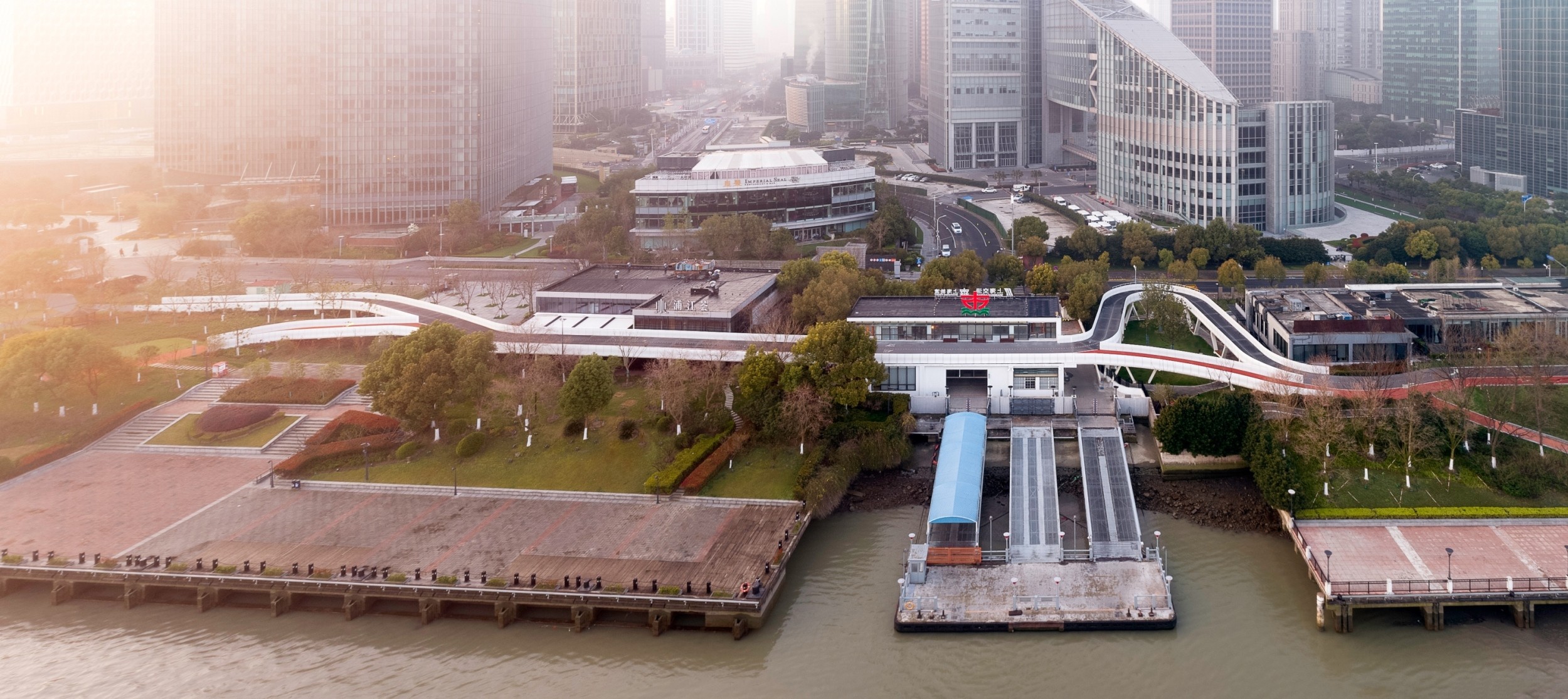
▼茂密树林中的跑步道与骑行道 © 梁山摄 bridge in the groove
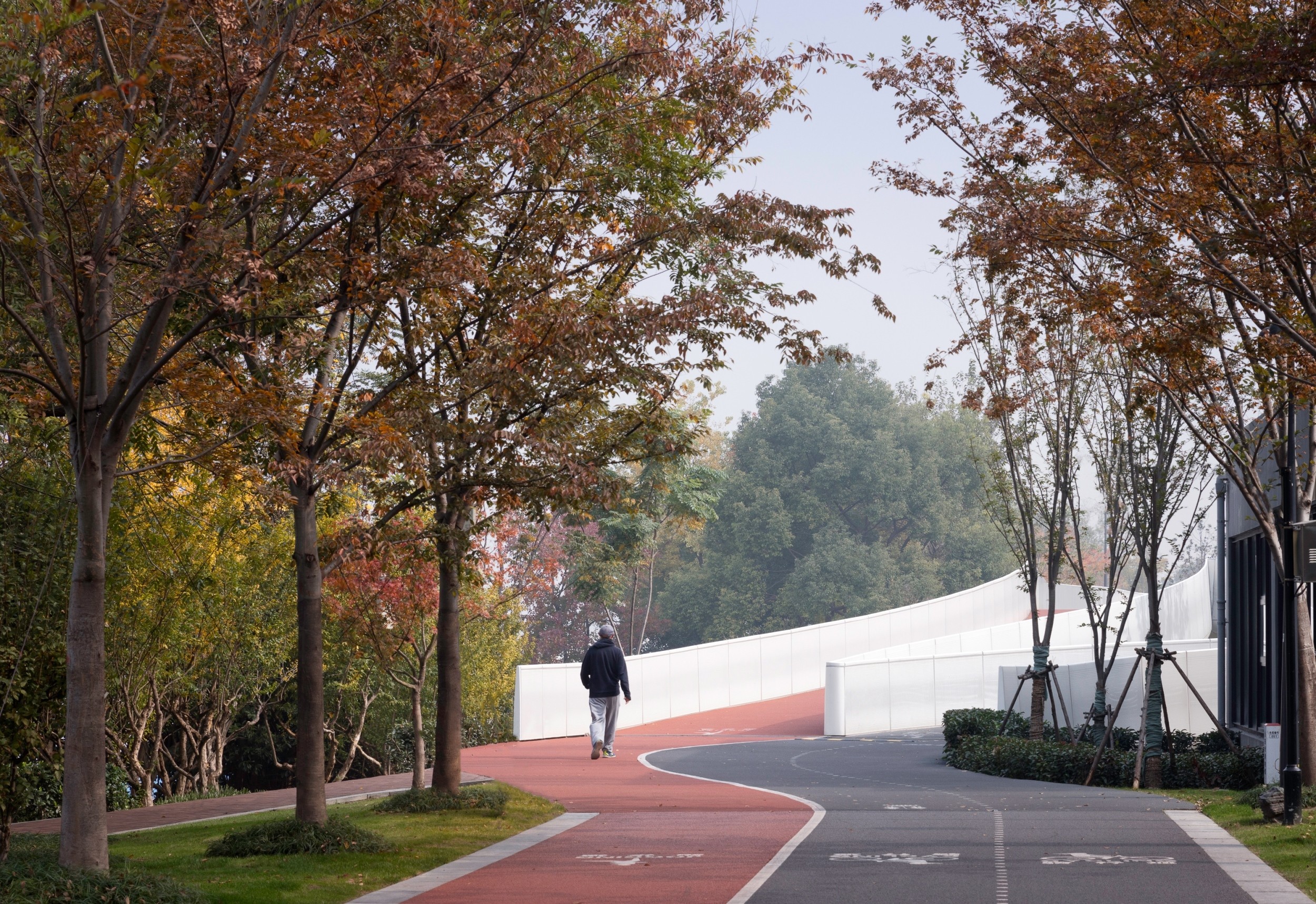
▼骑行道 © 梁山摄 cycling path
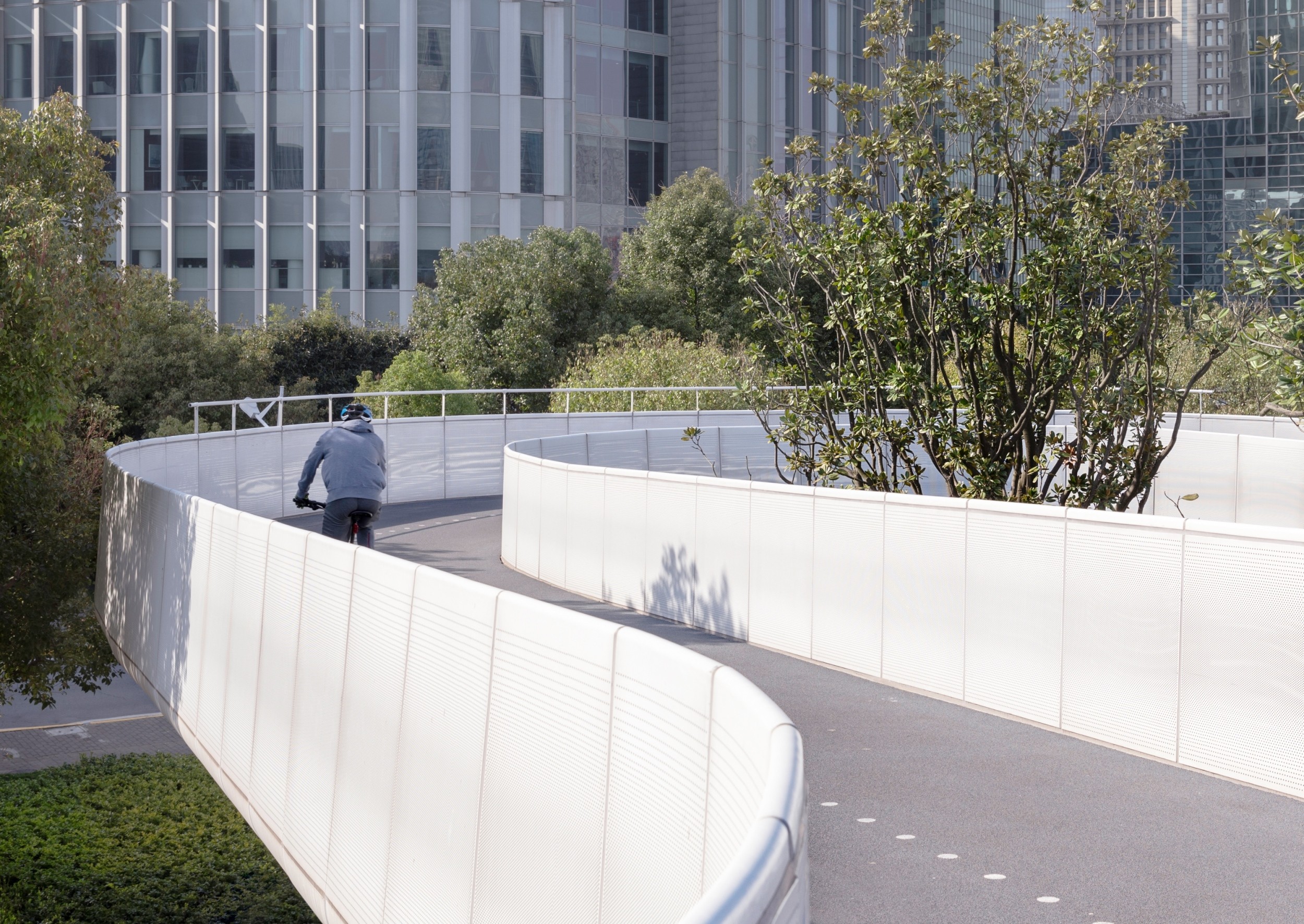
▼上部的流动空间 © 梁山摄 dynamic space above
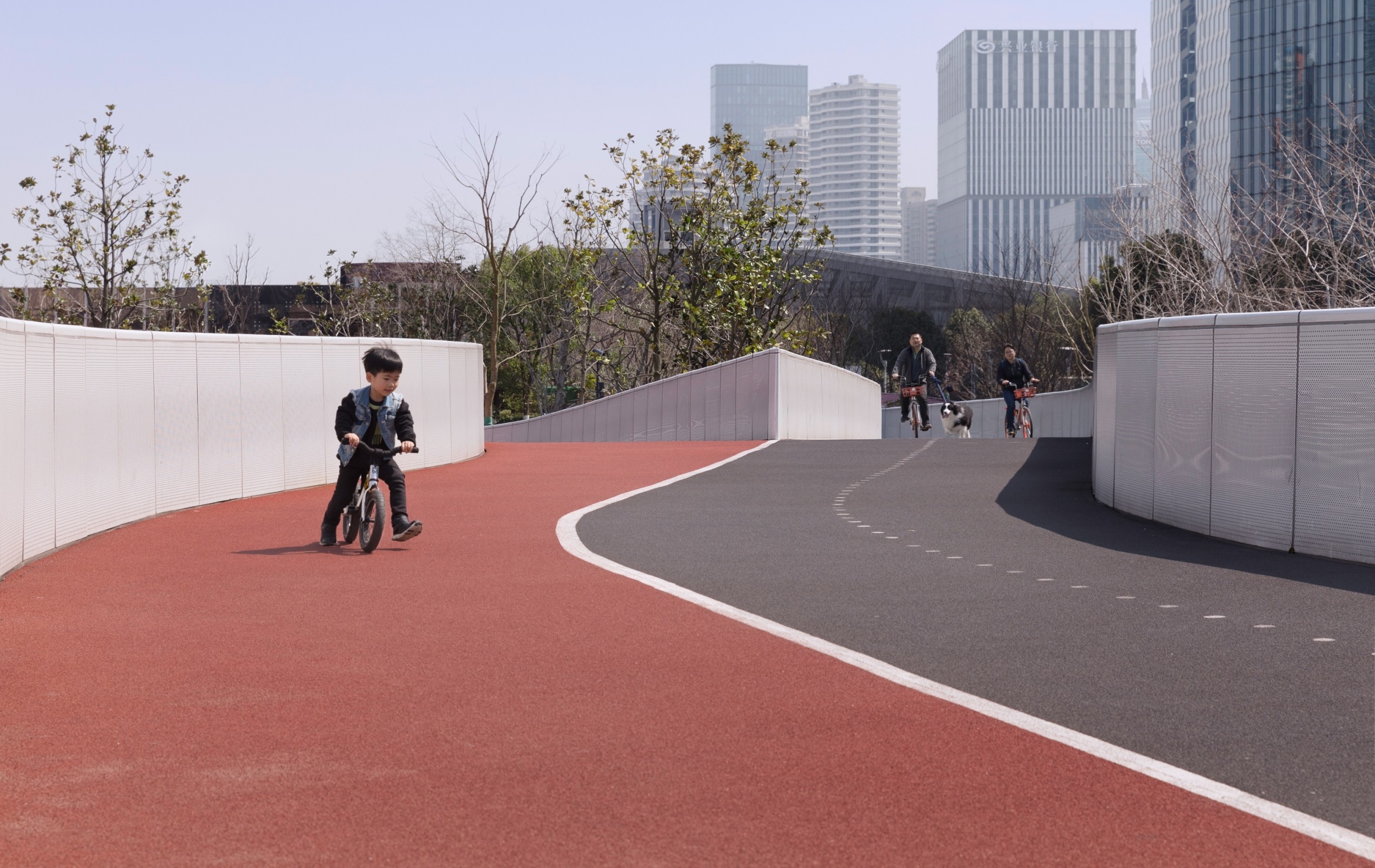
泰同栈慢行桥跨越泰同栈轮渡,将东侧的大都会广场和西侧的陆家嘴CBD绿地贯通,向西南可遥望东方明珠电视塔。桥体全长约180米,连同地面景观道路共约389米。慢行桥结合场地高差避让周边建筑,设计为两条蜿蜒的桥体,一条为骑行桥,一条为跑步漫步桥。之字形的桥身穿行于沿江植被茂密的景观带中,带领游玩和运动的人群在桥上慢慢行进和爬升,时分时合,在最高处汇集于泰同栈轮渡上方,或相聚在桥下庭院,故名曰"汇之桥"。
As one of the twelve bridges, the Pedestrian Bridge over Shanghai TaitongFerry Station - which is near the city’s landmark of Oriental Pearl Radio & TV Tower - connects the Metropolis Plaza at the eastern side and the Lujiazui CBD Greenland at the western side. The bridge itself is 180-meter long, and is connected to landscape pathways with a total length of 389 meters. According to different heights in the site, the bridge wind around surrounding buildings with two lanes for cycling and jogging/walking. The winding bridge passes through the lush vegetation in the riverside landscape belt, and leads those who are sightseeing or sporting on the bridge to move up and down. Peaking at the platform of the Taitong Ferry Station, or gathering at the courtyard under the bridge, different flows separate and mingle with each other at different points, which makes the bridge a medium for “interweaving flows”.
▼船只驶过江面的水痕与桥体的流线造型 © 梁山摄winding bridge and water splash left by boats
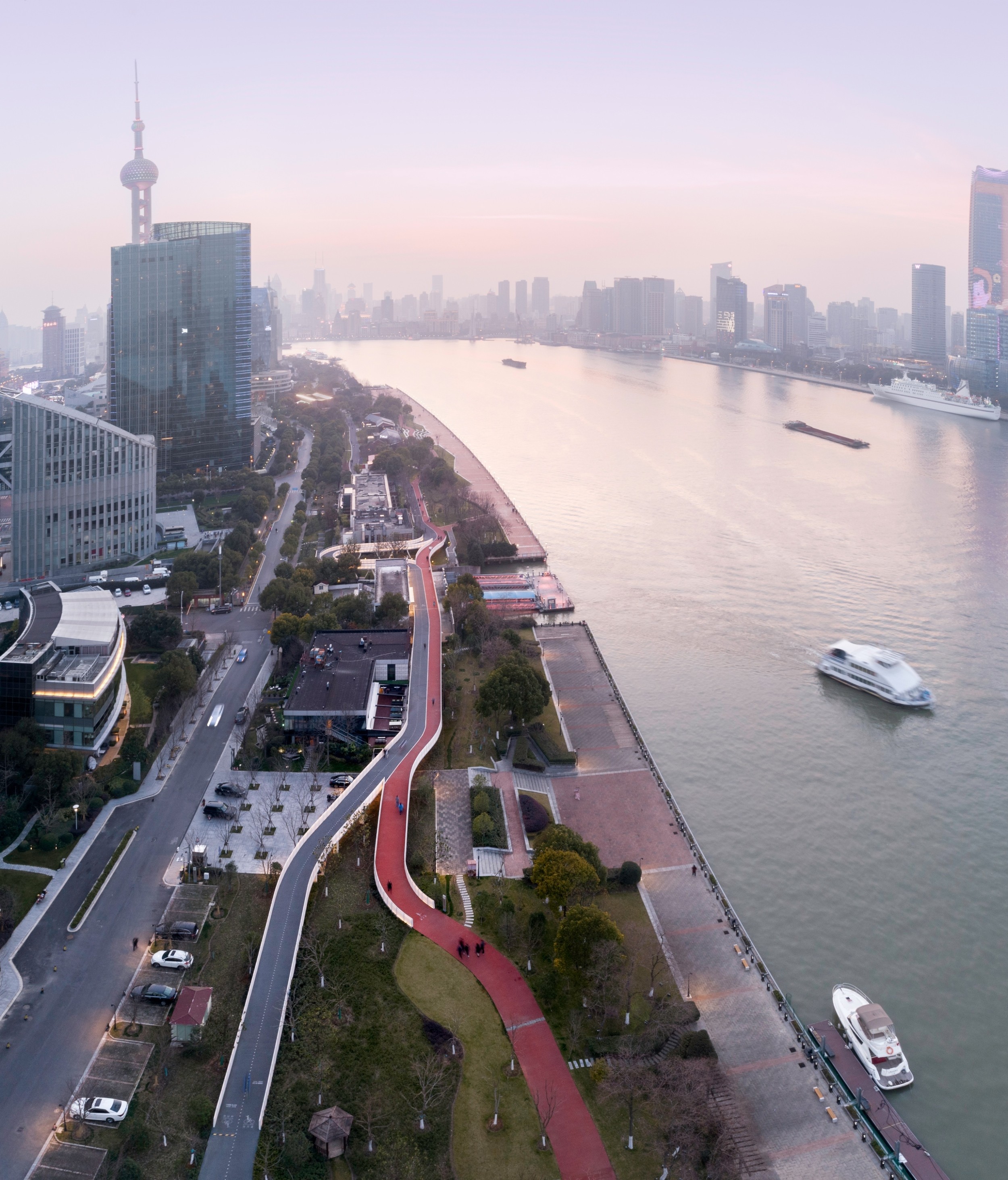
贯通
跑步、漫步、骑行这三条路径在过去被泰同栈码头打断无法贯通,慢行桥将三股人流汇聚在一起,在码头二层平台处进行跨越,实现三线贯通。设计同时考虑了穿越桥体和景观带到江边散步的人群流线,在泰同栈东侧中部设计桥下广场,引导人群走到江边。并在泰同栈西侧的街角空间设计庭院和小路,为滨江散步人群提供通行和休息场所。
Connectivity
Before the bridge was built, the TaitongFerry Stationseparated the waterfront spaces and disabled the circulations of jogging, walking and cycling. The pedestrian bridge crosses over the station to realize the connectivity of circulations along the bund. The design also takes into consideration the circulation of people going across the bridge and the landscape belt to the riverside: at the eastern segment, an under-bridge plaza is created to guide people to the bund; at the western segment, a courtyard and trails is designed near the T-junction of main roads, offering accesses to the waterfront and places to take a rest.
▼慢行桥上下的流线贯通 © 梁山摄 connectivity above and below the bridge
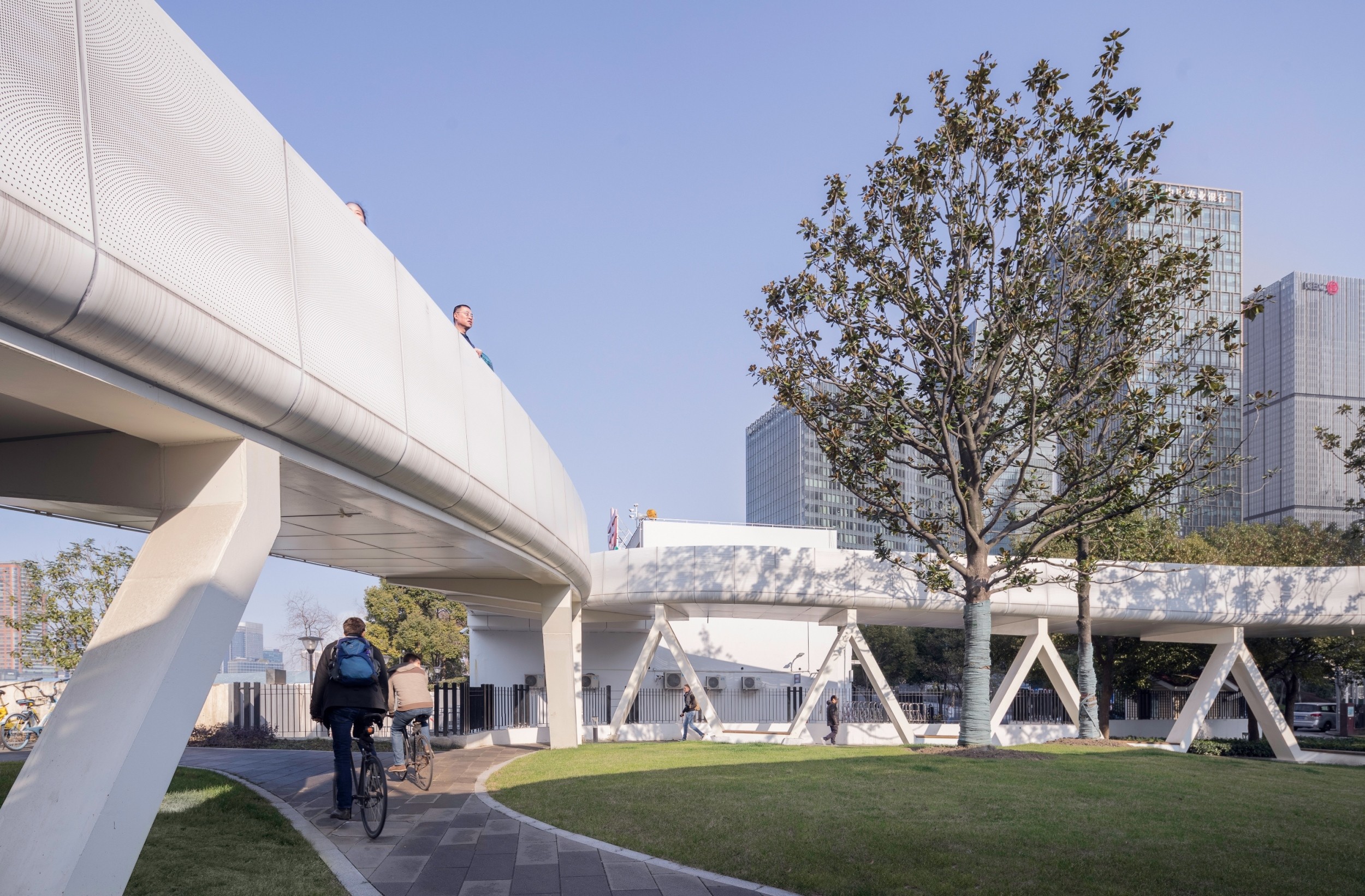
▼东侧起坡点 © 梁山摄 the eastern end
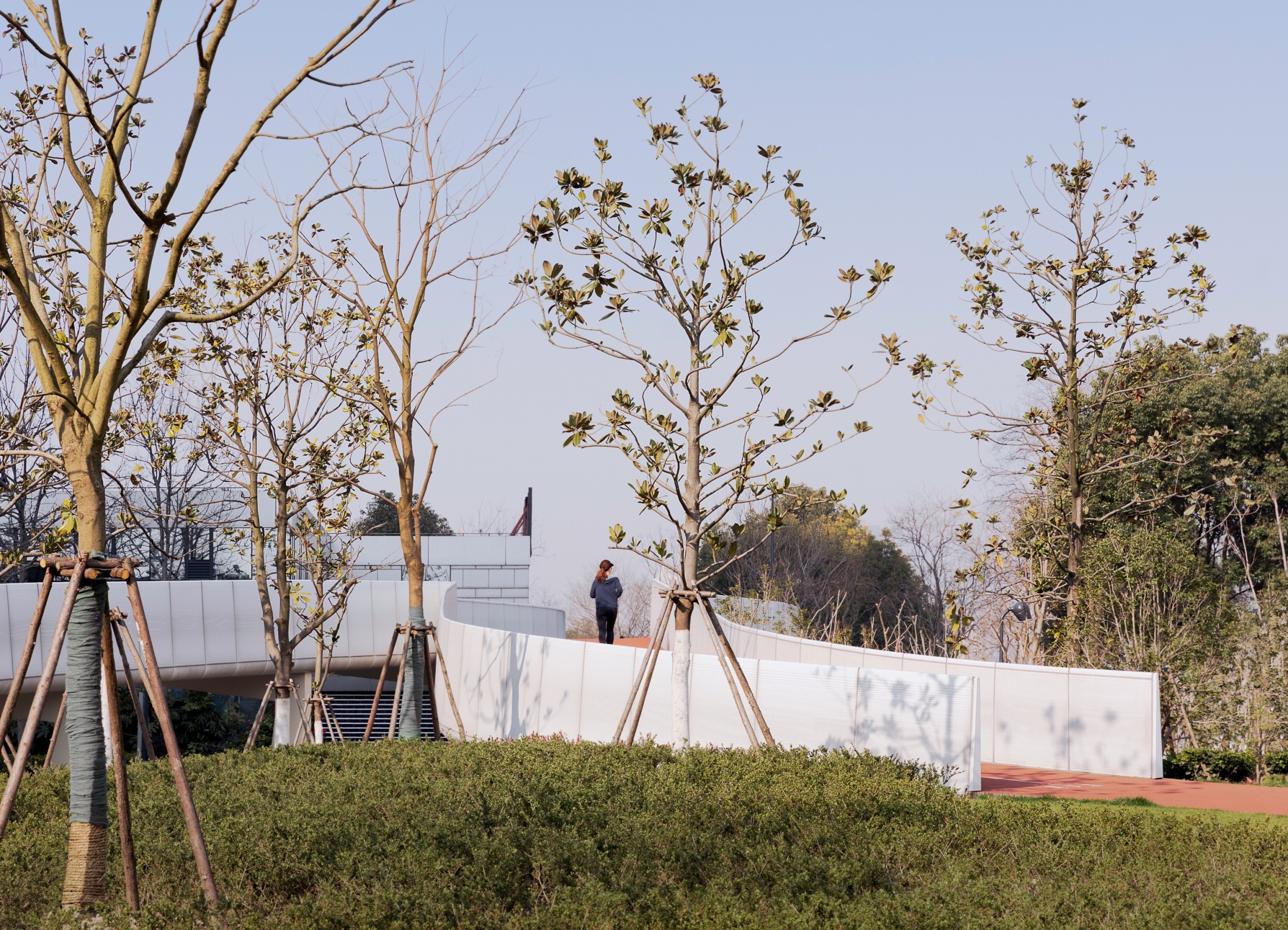
汇之
在植被茂密的沿江景观带中,三股人流通过两条优美蜿蜒的桥体汇聚,一条为骑行桥,一条为跑步和漫步桥。步行桥和骑行桥宽度均为4米,两桥合并处桥宽6米。
Interweaving Flows
In the dense grove of the landscape belt, different circulations of jogging, walking and cycling is gathered by two winding lanes. The lanes are 4-meter wide when separated, and 6-meter wide when jointed.
▼跑步道与骑行道的分合 © 梁山摄 seperation and reunion of the bridge
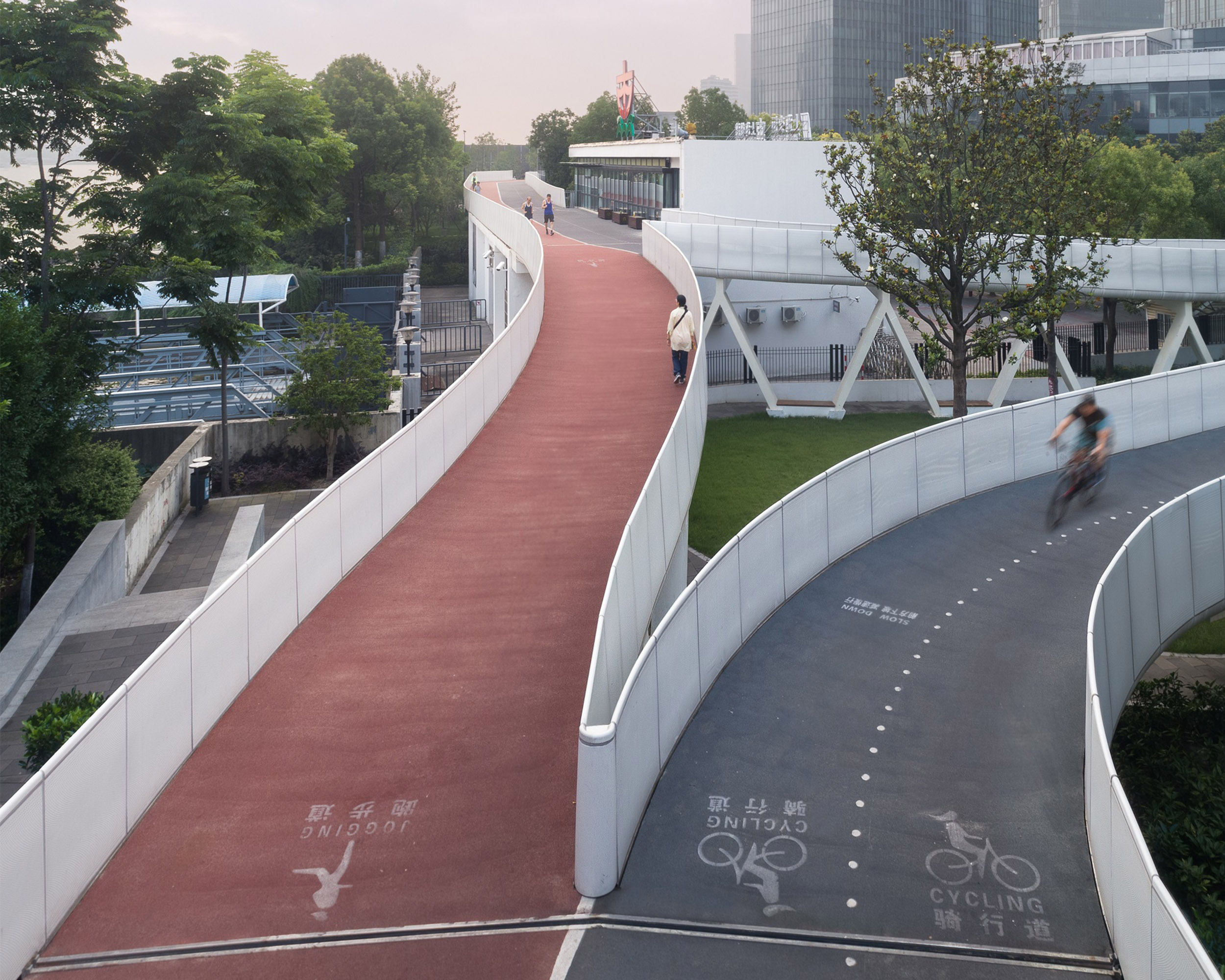
两桥将漫步、跑步和骑行的人从不同的景观道路接入,流线形的走势与黄浦江中船只驶过留下的蜿蜒水痕相呼应,仿佛林间的自由航行。根据自行车坡道与跑步道对于坡度的不同要求,两桥时而分叉,时而汇合,使通行者在双桥动态的聚散中得以相互交流并欣赏壮丽的江景,并在分合中自然围合出供人们小憩的庭院。
Introducing different circulations from different landscape paths, the bridge crosses through the grove freely in streamlined form, which corresponds to the water splash left by boats in Huangpu River. According to different requirements for slopes of cycling and jogging, the two lanes separate and mingle at different points, providing people with dynamic experience of interactionin the changing scenery of riverside. With the separation and the reunion of the lanes, a courtyard isnaturally created for people to stay and rest.
▼跑步道与骑行道的分合 © 梁山摄 seperation and reunion of the bridge
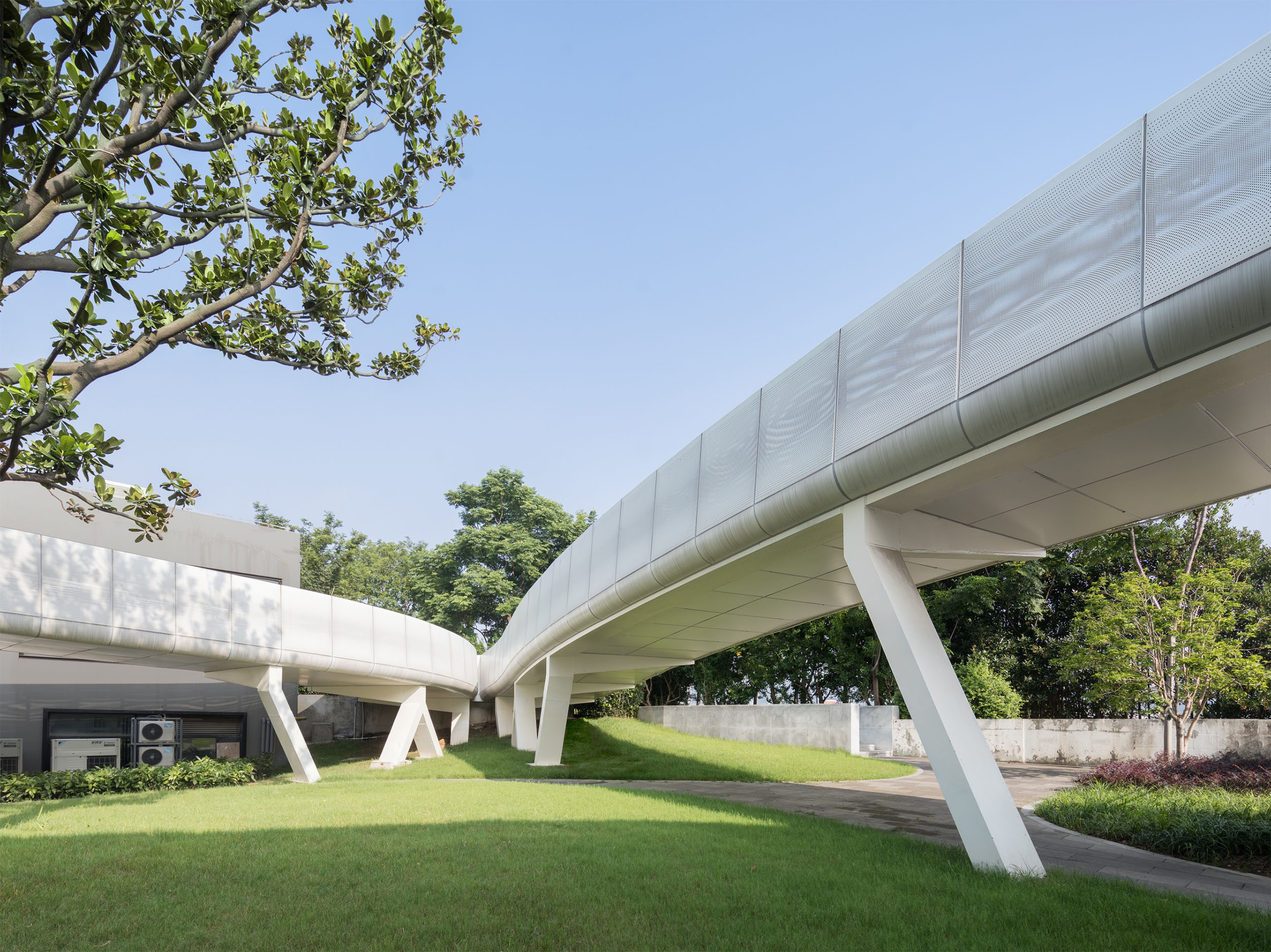
▼跑步道与骑行道的分合 © 梁山摄 seperation and reunion of the bridge
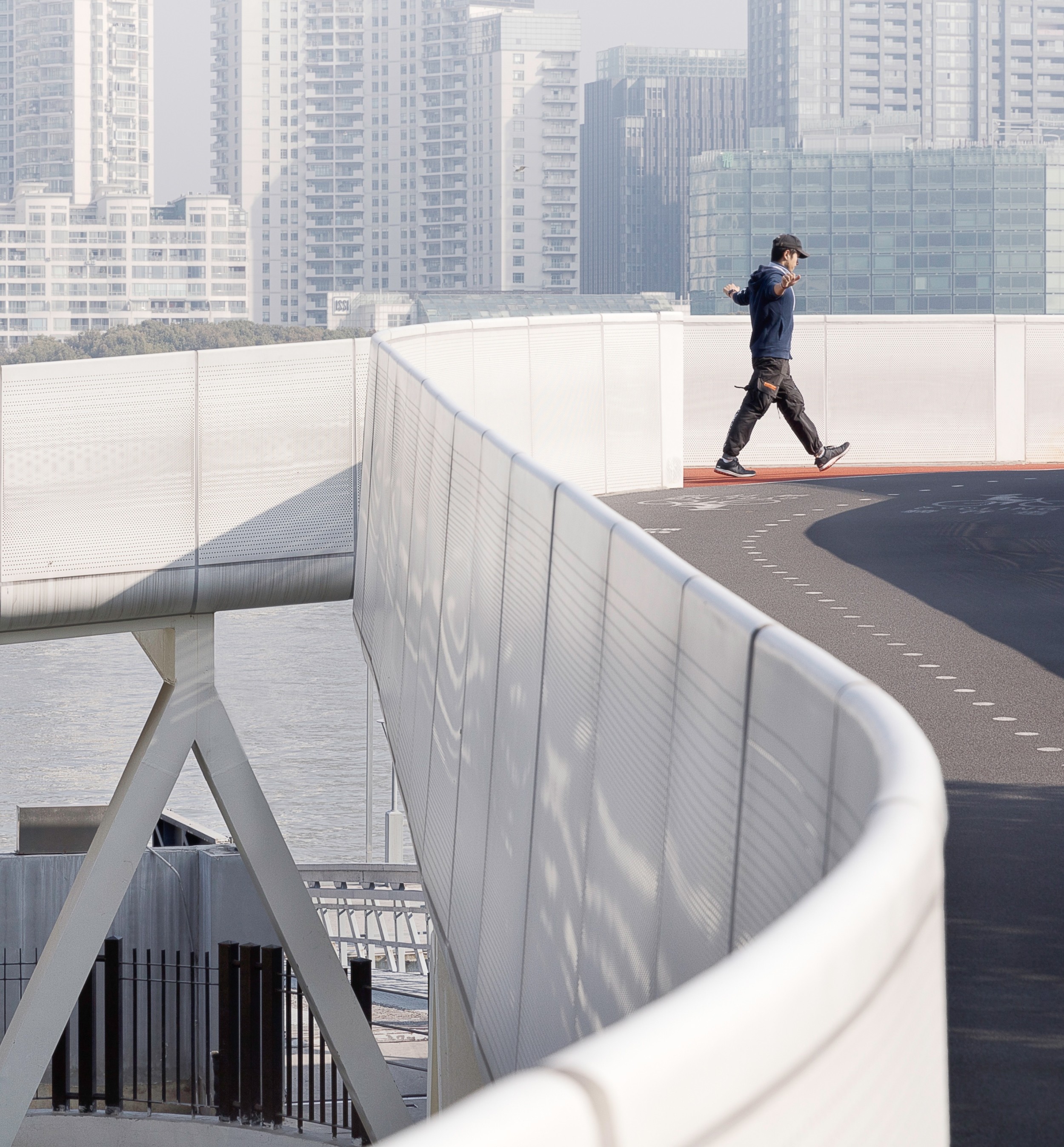
桥院
多种情境和氛围在汇之桥中被交织在一起。在行进的方向上,步行者和骑行者在桥上实现聚集和分离,桥上与桥下也形成了动静结合的空间,上部的跑步道与骑行道是活力的流动空间,而围合的庭院则是闲适的停留空间。在围合院落的桥下廊道中,桥面本身成为了廊顶,桥体底部的支撑结构则成了休息座椅。院落中央栽种的树木更进一步强化了院落的意向,为人们提供宜人的休憩空间。
Bridge-courtyard
Multiple scenes and atmospheres are interwoven together in the design. Along the bridge, there is the separation and reunion of walkers,joggers and riders, while above and below the bridge, there are dynamic and serene spaces with the upper part being the active flowing space and the courtyard below being the quite staying space. In the courtyard, the bridge itself becomes the roof of the corridor, and the columns’ foundations become the seats. The trees planted in thecenter emphasize the idea of traditional courtyard, and offer comfortable shadow to the citizens.
▼桥院鸟瞰图 ©梁山摄 birdview of bridge-courtyard
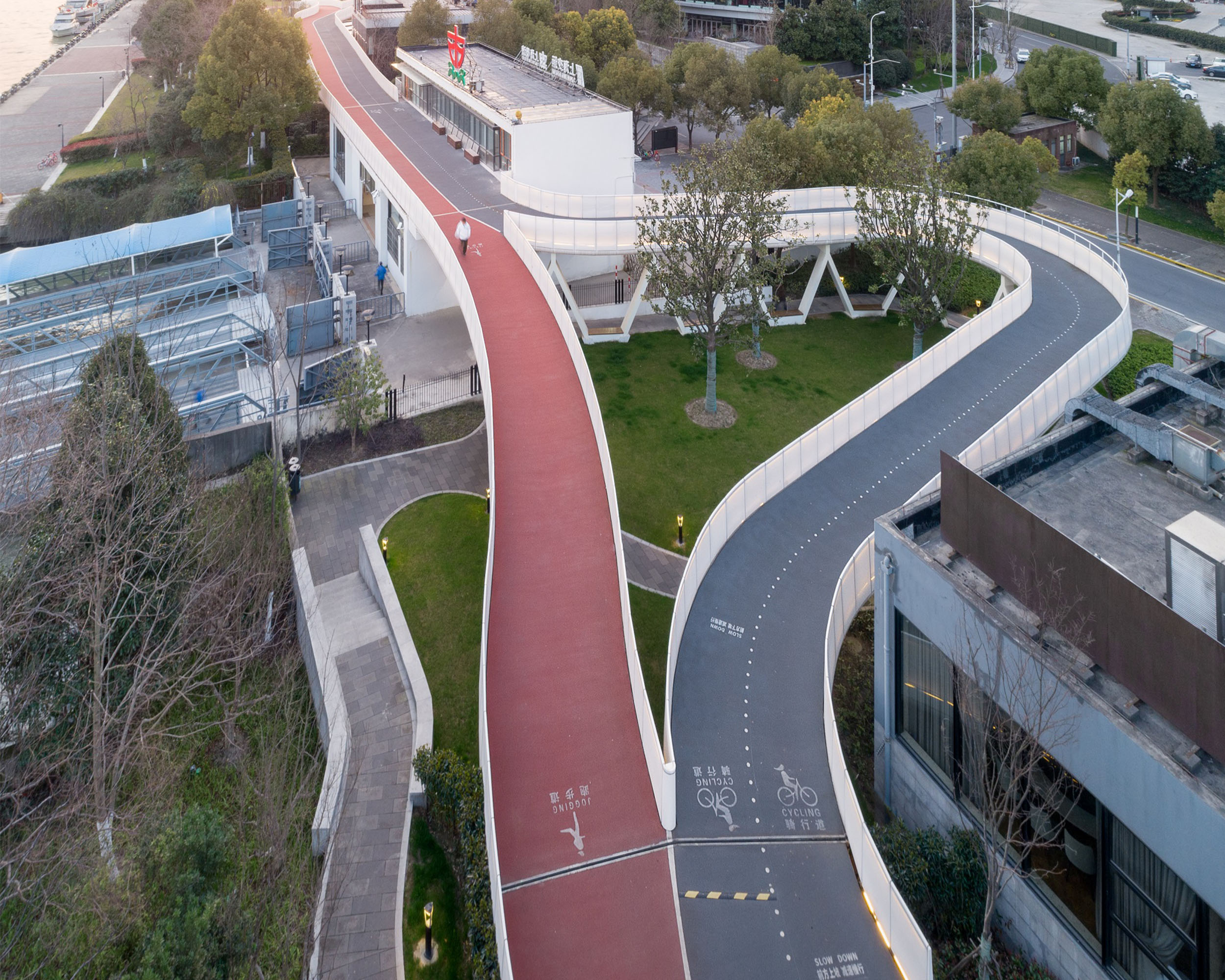
▼弯道处的桥院 © 梁山摄 bridge-courtyard at the bend
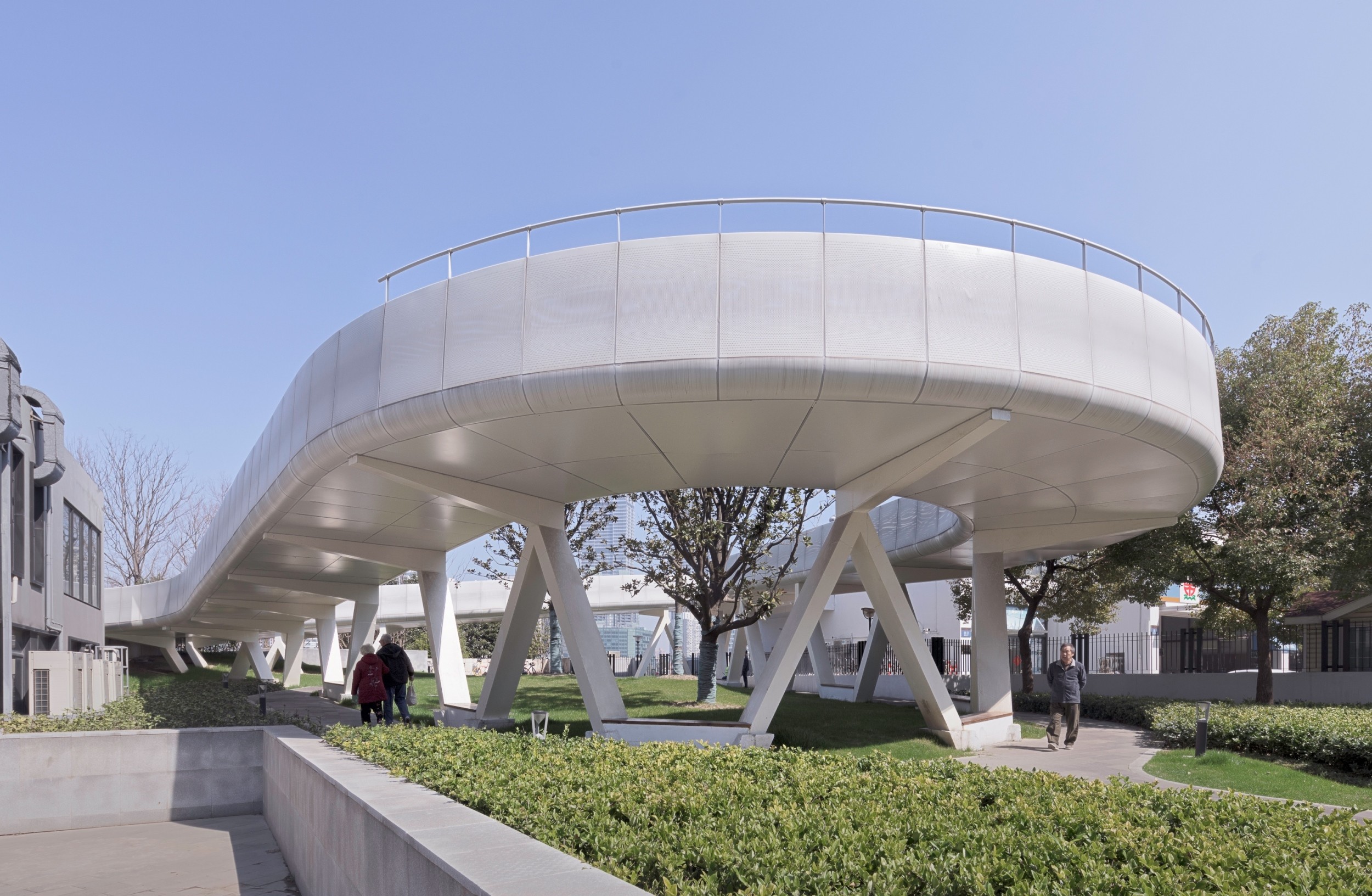
建构
为保证桩基退让防汛墙6米间距,桥体多采用单面悬挑钢结构支撑。以泰同栈码头为分界,结构设计采用了两种结构柱形式。泰同栈以东是独立变截面柱,为底层提供了开敞的空间和通透的视野,泰同栈以西的庭院则采用斜柱,强化了庭院的围合性。
Tectonic
To ensure the 6-meter setback from the flood control wall, one-side cantilever steel structure is used. Two types of columns are utilized at two sides of the Ferry Station. At the easternside of the station, tapered straight columns are used to offer visual corridor to the bund, whereas at the westernside, inclined columns are used to emphasize enclosure of the courtyard.
▼下部的休憩空间 © 梁山摄 serene space below
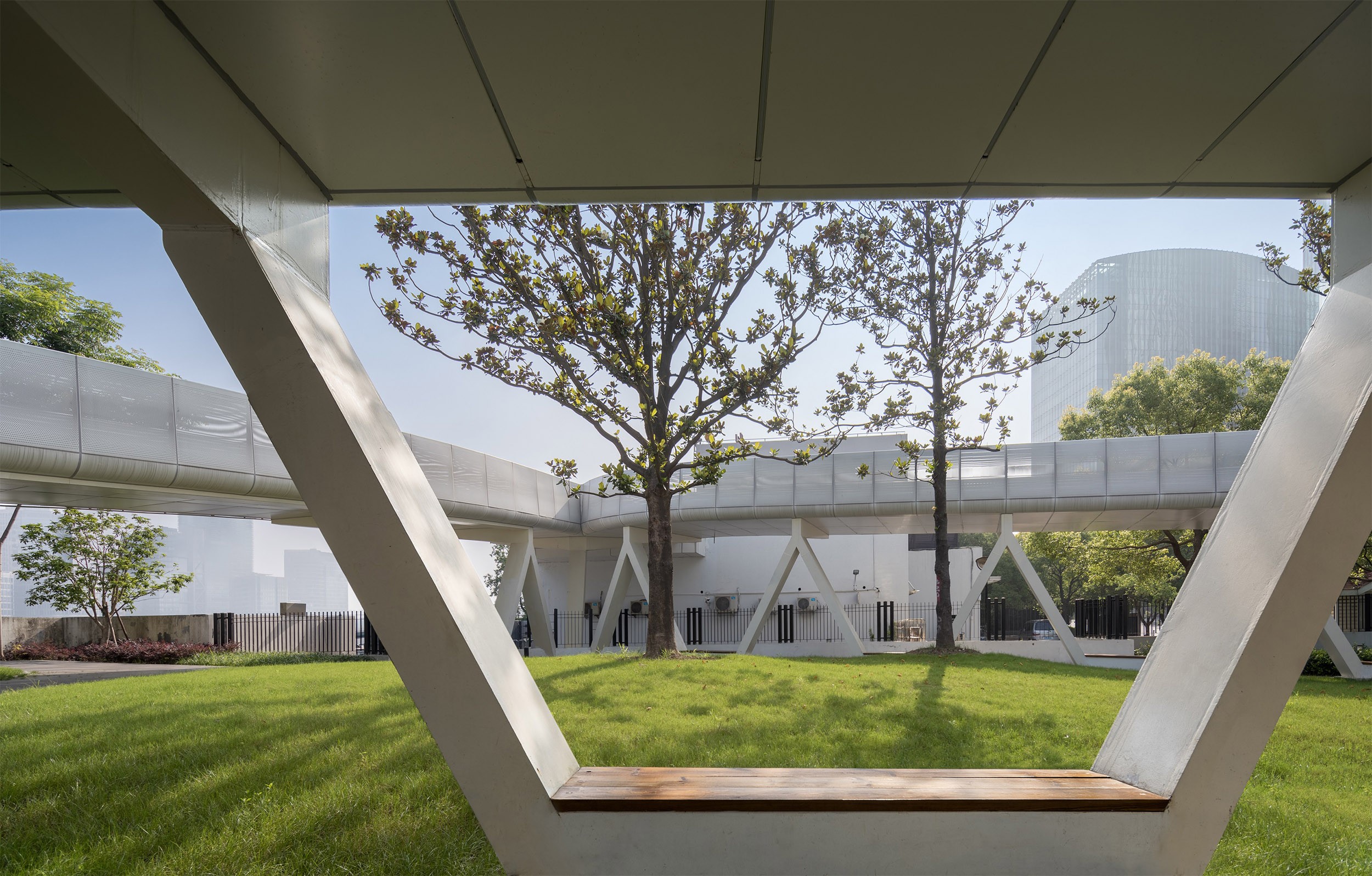
▼斜柱与挑梁 © 梁山摄 inclined columns and cantilever beam
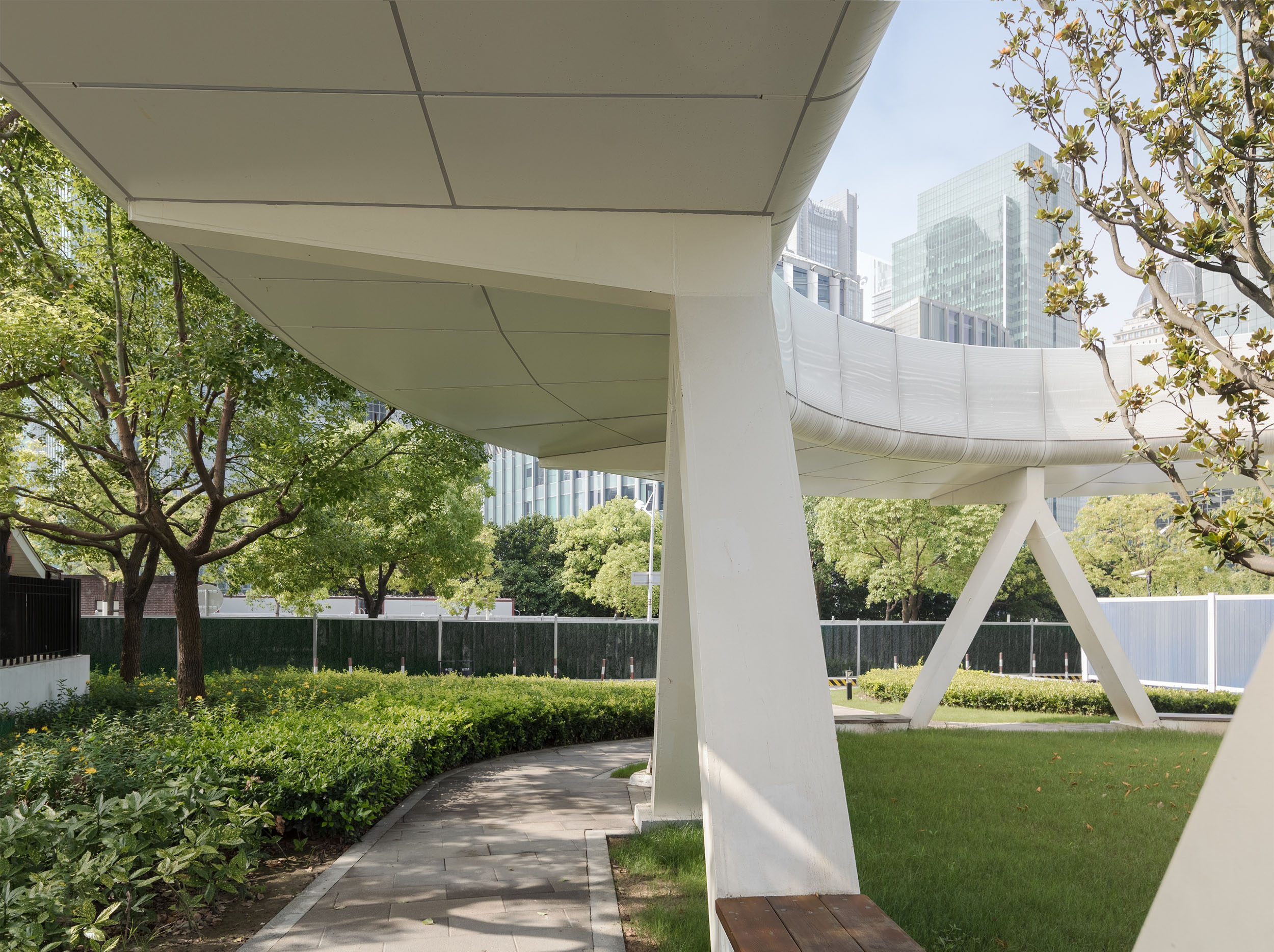
桥体外侧包覆铝板,在栏板处采用了穿孔铝板弯折成形,使栏杆和桥面衔接为抽象流畅的整体。穿孔铝板表面设计了渐变的冲孔,以一种柔和与微妙的方式强化了流畅的形体线条,并为夜晚内透的灯光效果提供更为有趣的变化。
Aluminum panels are the main material to cover the bridge. Bended and perforated aluminumpanels are usedto ensurethe integrity of the form. The holes on the perforated panels are designed with gradually changing diameters, which strengthens the streamlined form in a subtle wayand filters the LED belt inside with a unique pattern.
▼穿孔铝板栏板 © 梁山摄 perforated aluminum panel
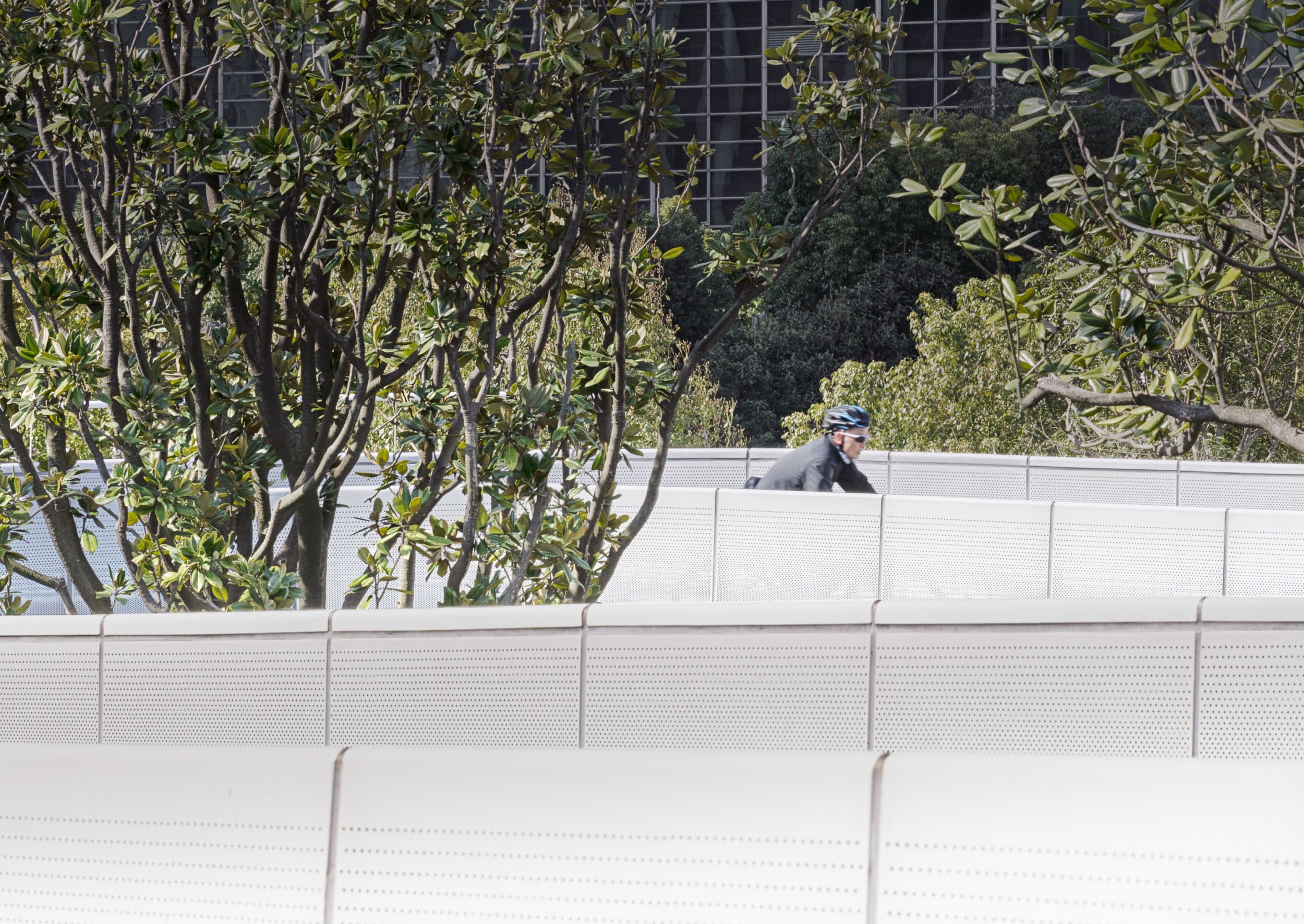
▼穿孔铝板栏板 © 梁山摄 perforated aluminum panel
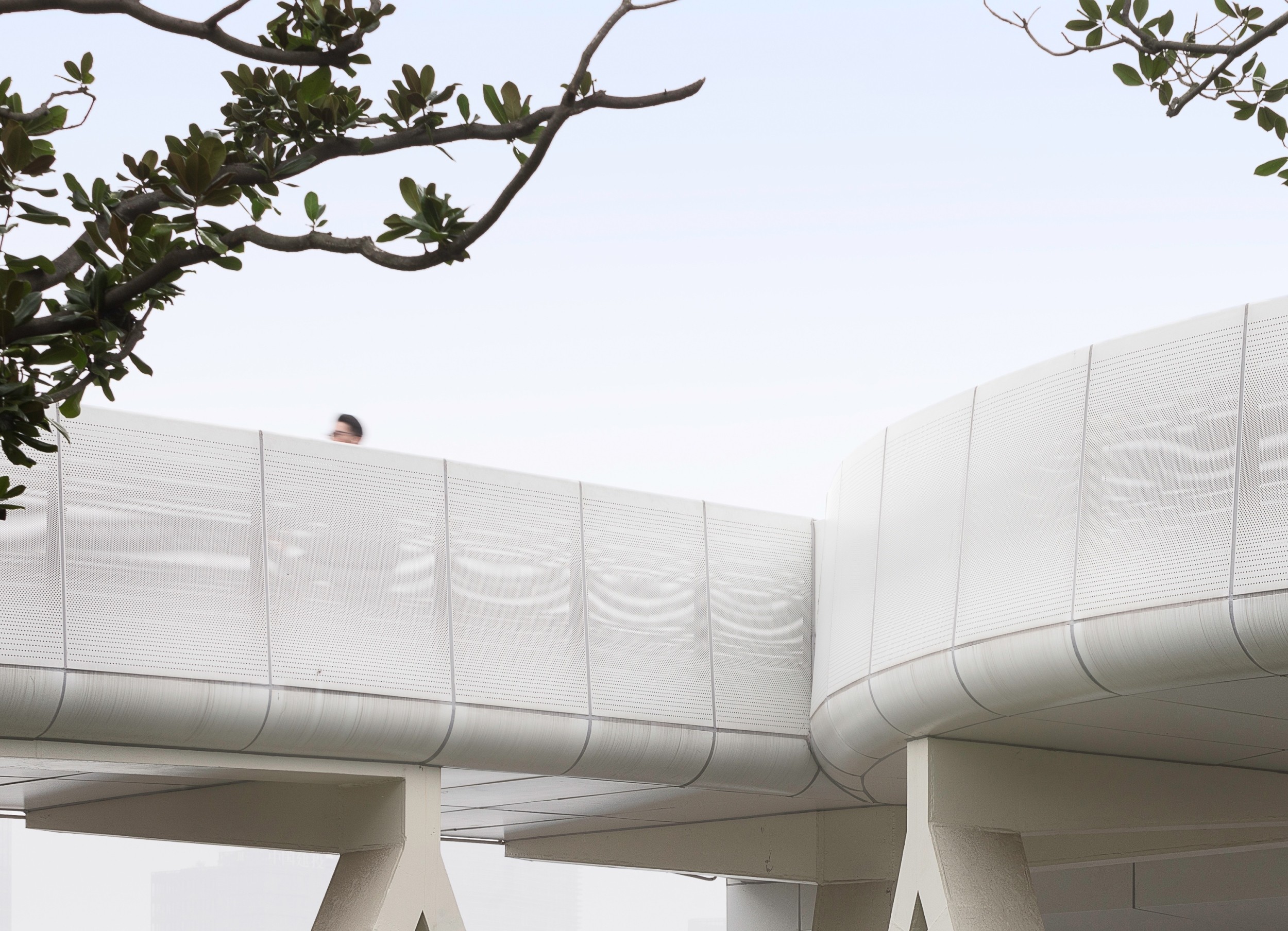
夜幕降临,通长的灯带透过穿孔铝板发出均匀的光亮,将整个桥体打亮,远远望去,犹如两条轻盈的光带划过树丛倒映在江面上。这一整体性的灯光设计为都市居民提供了夜间通行的照明,提升了区域的全时段活力。
As night falls, soft light penetrates through the perforated aluminum boards, and the bridge is reflected on the river like two shimmering beltsacrossthe grove. The lighting design provides illumination for citizens’ night activities, and helps to promote the all-time dynamism of the larger area.
▼北侧夜景鸟瞰图 © 梁山摄 nighttime birdview from the north

▼流线分析
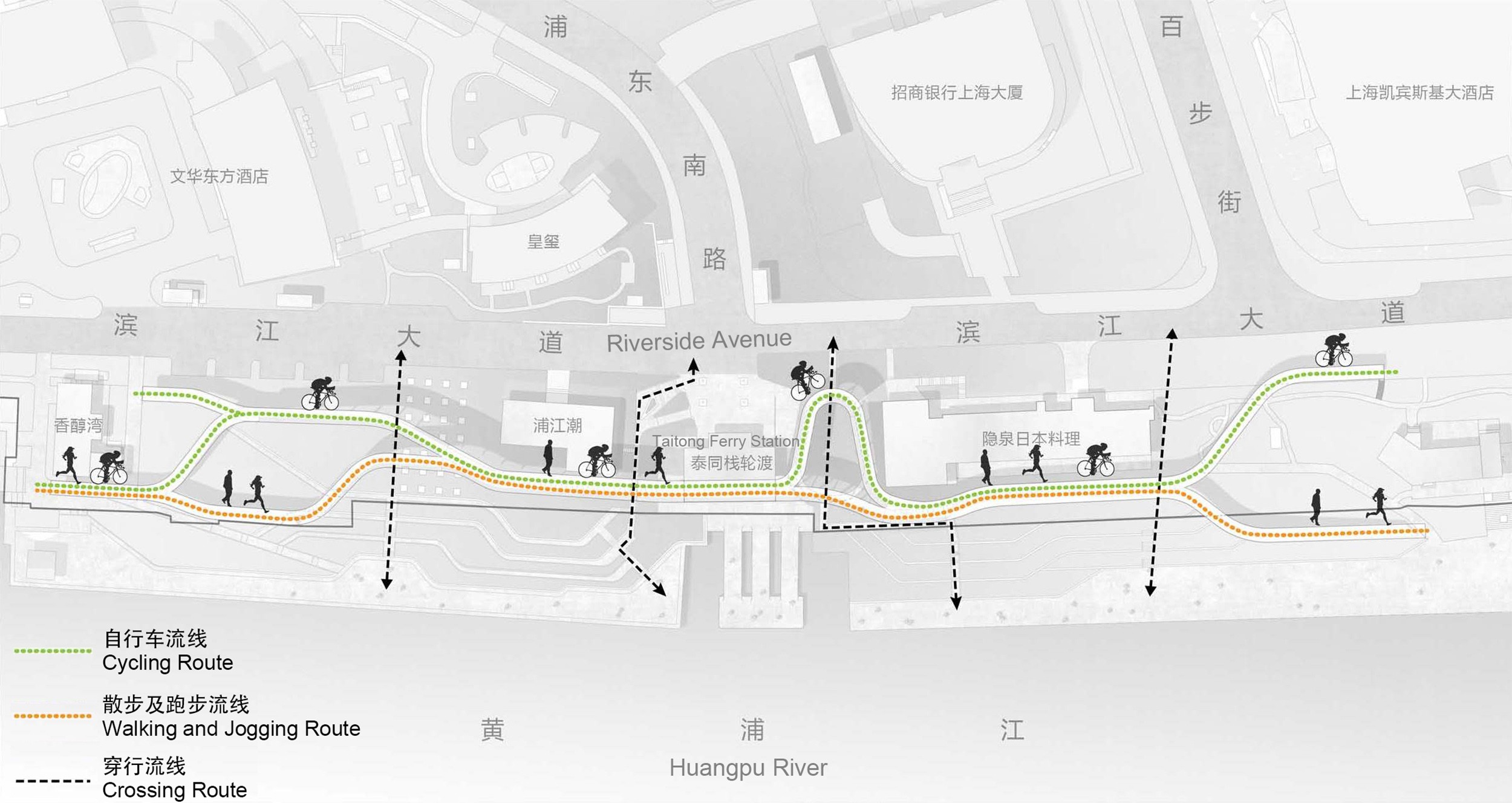
▼结构模型
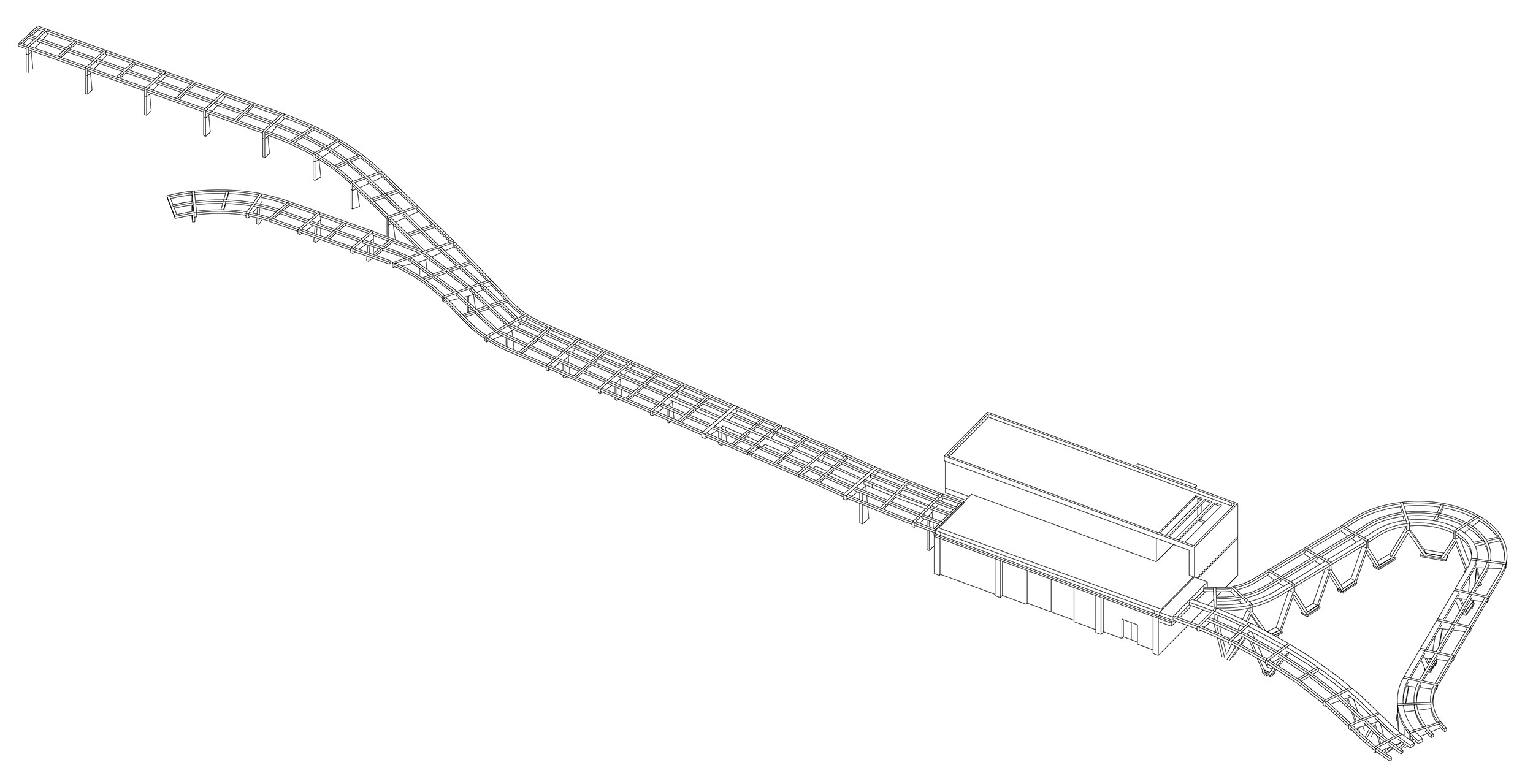
▼总平面图
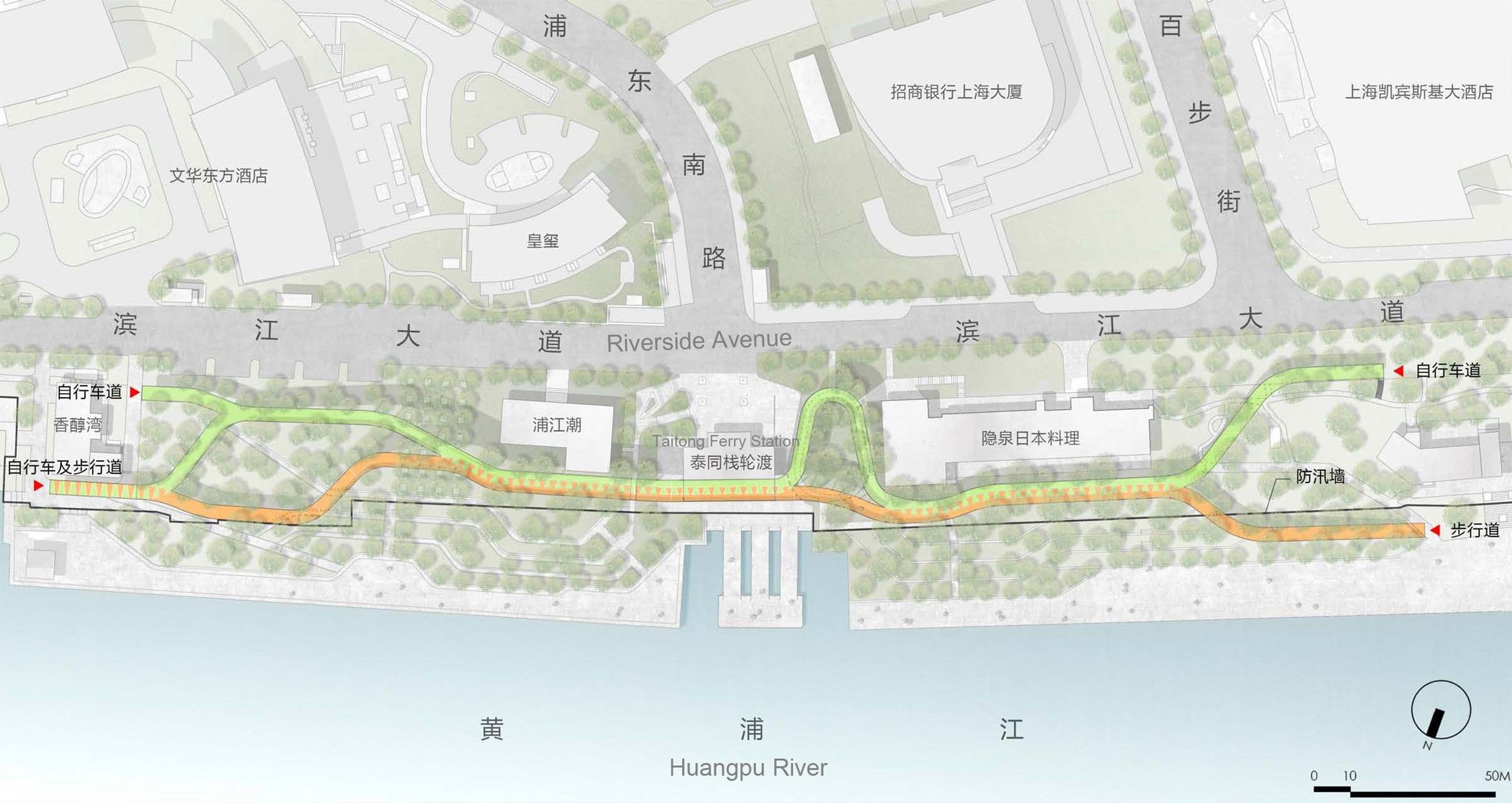
▼剖面图
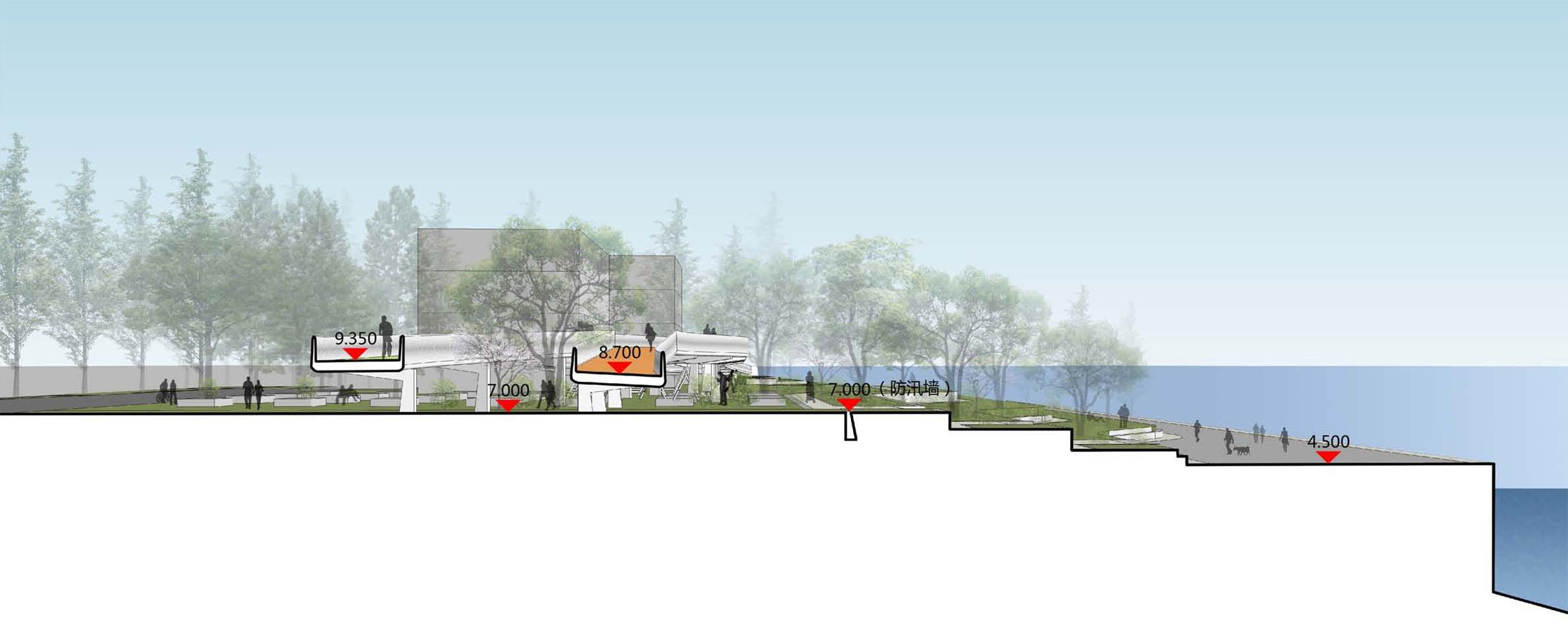
▼剖面图
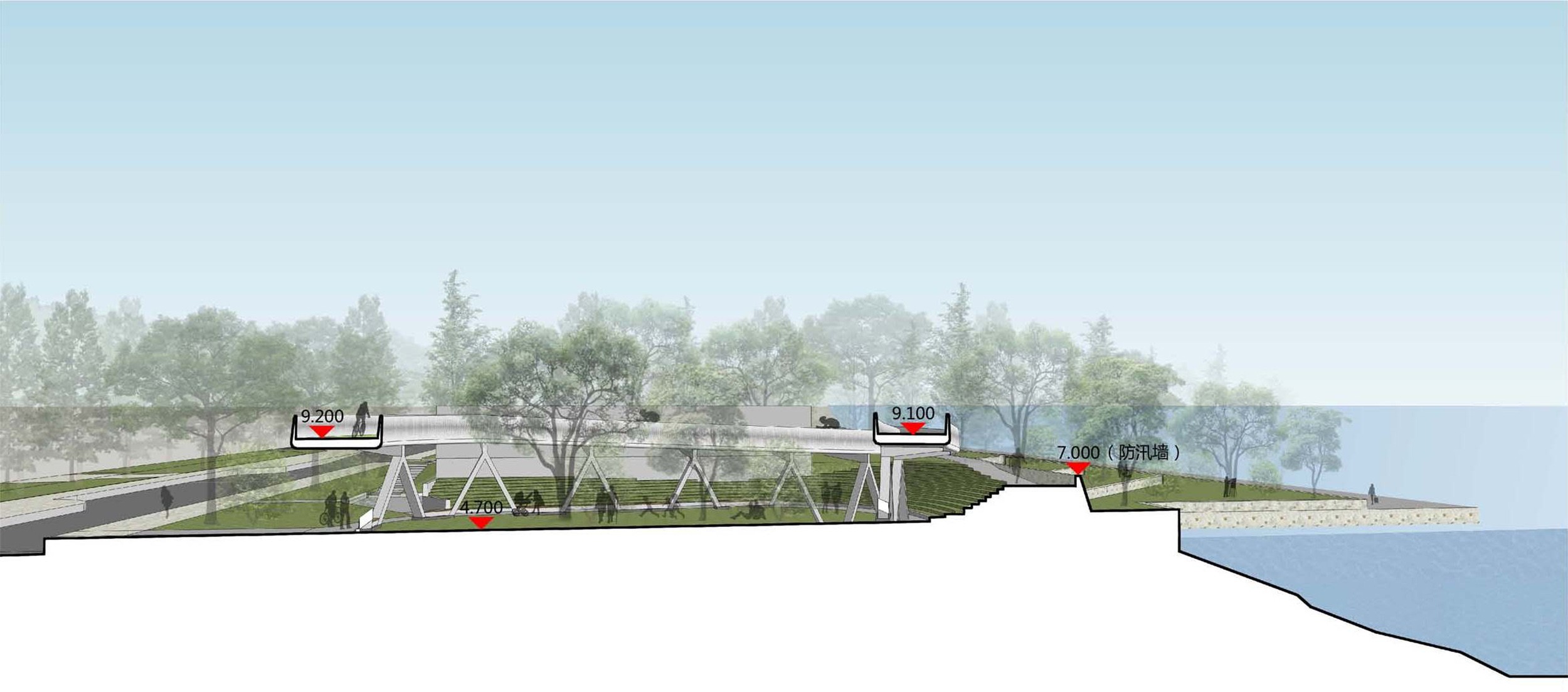
项目地点︱上海浦东新区泰同栈
建筑功能︱慢行桥
项目规模︱桥长180m
设计/建成︱2016 / 2017
设计团队︱祝晓峰(设计总监)、李启同(项目经理)、江萌(项目建筑师/驻场建筑师)、梁山、杜洁、周延、刘培斌
业主︱上海东岸投资(集团)有限公司
结构顾问︱张准/和作结构建筑研究所
合作设计院︱上海市政工程设计研究总院(集团)有限公司
施工单位︱中建八局
结构体系︱单面悬挑钢结构
主要用材︱穿孔铝板、白色铝板、白色氟碳喷涂、双组份聚氨酯改性环氧树脂
摄影︱梁山
Project Data
Location︱Taitong Ferry Station, Pudong New District, Shanghai
Program︱Low-speed bridge
Scale︱180m in length
Design/Built: 2016/2017
Design Team︱Zhu Xiaofeng(design principal), Li Qitong (project manager), Jiang Meng (project architect,on-site architect), Liang Shan, Du Jie, Zhou Yan, Liu Peibin
Client︱Shanghai East-Bund Investment (Group) Ltd.
Structural Consultant︱Zhang Zhun/AND Office
LDI︱Shanghai Municipal Engineering Design Institute (Group) Co., Ltd
Contractor︱China Construction Eighth Engineering Division Corp., Ltd
Structural System︱one-side cantilever steel structure
Main Materials︱perforated aluminum panel, white aluminum panel, white fluorocarbon coating, two-component polyurethane modified epoxy resin system
Photographer︱Liang Shan